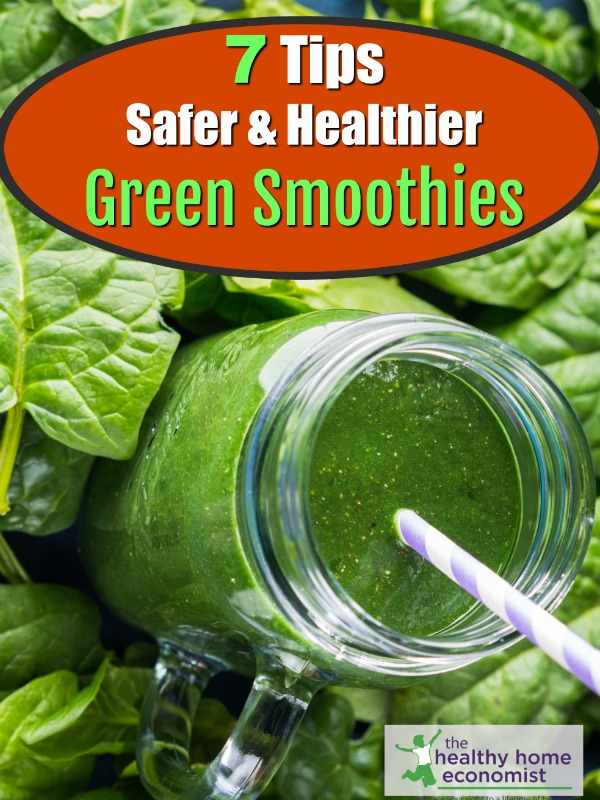
One of the most controversial articles on this site is how the green smoothie diet can actually be dangerous rather than beneficial to health over the long haul.
Since the original publishing date of that article in 2012, I have received dozens of emails from people who unfortunately discovered firsthand how green smoothies can negatively affect health, sometimes devastatingly so.
The typical scenario described was an initial energy and health boost (likely due to the detoxification effects), but over a period of months or even years, a dramatic health reversal or crisis occurred such as hospitalization due to tissue pain or organ malfunction from oxalate crystals. Sometimes, a strict, low oxalate diet was required to facilitate recovery.
Another significant health risk is blowing out your thyroid from overconsumption of the goitrogenic cruciferous vegetables commonly used in green smoothies. These include kale, broccoli, collard greens, arugula, maca, bok choy and others.
On the positive side, I have also received messages from people who were able to finally resolve chronic kidney stone or fibromyalgia issues once they significantly reduced or eliminated their green smoothie intake in favor of salads and/or veggies cooked in a healthy fat.
As mentioned in that original article, the main problem with green smoothies is overdoing it. This is unfortunately the typical scenario in Western culture. If something is good for you (like green vegetables), more is always better right?
Wrong.
While I myself don’t consume green smoothies, there are simple ways to incorporate them that won’t trigger the problems of excess if you truly enjoy them.
Here are some tips to consider the next time you visit the juice bar or fire up the blender.
Symptoms of Green Smoothie Excess
Ayurveda is a system of traditional medicine from India based on the 3 doshas (physical and emotional tendencies): Vata, Pitta, and Kapha.
The Ayurvedic perspective on green smoothies is that they aggravate the physiology of many people, particularly the Vata dosha. Those for whom the Vata dosha predominates are characterized as being constantly on the go with an energetic and creative mind. Imbalances are experienced as one or more of the following symptoms:
- Inconsistent appetite
- Gas or pain after eating
- Bathroom issues (constipation or loose stools)
- Dry/rough skin and hair
- Variable energy
- Poor circulation
- Pain or cracking in the joints
- Mental agitation
- Restlessness
- Flightiness
- Anxiety
- Poor concentration
- Poor memory
- Changeable moods
- Insomnia
In addition, Ayurveda warns that green smoothies are hard to digest in general due to the high fiber content which is experienced as long lasting fullness. Most people think this is a good thing, but it is not! It is actually an indication of indigestibility.
Finally, Ayurveda cautions that greens smoothies are associated with catabolism or the breaking down of tissues. This is experienced over time in the following ways: bone issues, compromised nerve conduction, hormone issues, infertility, auto-immune woes, chronic fatigue, other diseases of depletion.
7 Tips for Safer Green Smoothies
The tips below are recommended by Everyday Ayurveda as ways to make the occasional green smoothie a healthier practice and more in accordance with traditional Ayurvedic principles for a smooth, easy digestive experience:
- Add a pinch of turmeric and ginger and a squeeze of lemon to the mix to aid digestion.
- Be sure to never drink cold green smoothies. Make sure they are at room temperature or at least add a little hot water. While pleasurable on a hot day, cold drinks are actually very hard on the digestion and can impede mineral absorption.
- Keep the ingredients to a minimum – simple and less dense is better.
- Add a little coconut oil to offset the dry, fibrous qualities of the veggies. The addition of fat also serves to facilitate better absorption of the nutrients.
- Try them without fruit.
- Avoid the addition of superfoods like maca powder or protein powder. They make them even heavier. Collagen hydrolysate would be well tolerated by most people, however.
- Only have a green smoothie a couple of times a week at most. Not daily!
Another reason to avoid the addition of superfoods particularly if they are green powders is because these powders are prone to rancidity even if they are refrigerated or packaged in capsules (1). The one exception to this is kelp which is very salty which seems to serve as a natural preservative.
Cooked Veggies in a Green Smoothie?
Another alternative to the typical raw green smoothies is to make them with cooked vegetables instead. While cooking vegetables does result in some loss of nutrition and enzymes, the gains to overall digestibility more than compensate.
This can be accomplished one of two ways according to Dr. Lawrence Wilson MD, a pioneer of nutritional balancing. These are the only methods for preparation of green drinks that he suggests to patients who want to drink them (2).
Using a Vita-mix
Place some roughly chopped vegetables in your Vita-Mix and turn on the speed to maximum. Continue the mixing process for a full 5 minutes after the machine chops up the vegetables very finely. This continued spinning actually serves to lightly cook and warm the vegetables.
Using a Blender
Cook up the vegetables you wish to include in your green smoothie over the stovetop for at least 25 minutes. You may wish to include some carrots or onions for sweetness.
Next, put the cooked vegetables into a standard blender or use a hand held blender to whip it up into a thick drink. Do not add a lot of water, as this interferes with digestion by diluting digestive juices. Using a hand held blender will require less water added, and so is the preferred option.
Do you drink green smoothies? If so, what precautions have you found encourage better digestion to avoid the downside of oxalates and goitrogens in so many of the most popular green smoothie vegetables?









Another big problem with green smoothies that it leads to over dosing on vitamin A, which can be fatal! Vit. A is fat-soluble and it builds up over a lifetime. I’m still in recovery from hypervitaminosis A after almost 2 years on a low-A diet!
The vitamin A in green smoothies is all from beta carotene, which is not true vitamin A. https://www.thehealthyhomeeconomist.com/beta-carotene-vitamin-a-myth/
The body must convert carotenes to true vitamin A and the conversion is very inefficient (5% or so) and in those with gut dysbiosis, probably doesn’t happen at all.
The addition of extra fiber may help offset oxalate calculi. The addition of fiber to the diet in a Japanese study on lithiasis some years ago was effective in subjects who experienced oxalate-based stone formation. It was reasoned that the oxalate would bind to the fiber and get removed via the intestinal route rather than placing a burden on the kidneys. One could add grapefruit pectin. I prefer a prepackaged blended fiber matrix about 15 mins before meals. Upping citrate consumption is known to help too.
How about: Leave out the high oxalate fruit and veg. It’s not like there aren’t enough low or medium oxalate choices available, one just needs to know exactly which ones they are.
Also, adding some calcium would seem like a good idea because it will bind with some of the free oxalate, and the insoluble calcium oxalate is not absorbed as well.
It’s not just oxalates. Goitrogens in cruciferous veggies (like kale a favorite for smoothies) are a problem too which suppress thyroid function.
Good advice ,I precook all my green leafs and add calcium carbonate powder in the boiling water that is said it removed large some of oxalate , and alternated my 1/4 cup green in my smoothie every day, what do you think of that Sarah ?
That is a smart approach. I would also suggest not having them every day … only 2-3 times a week. Remember that goitrogens in crucifers isn’t reduced much by cooking. The amount of greens you can cram into one smoothie does not equate to what you would actually eat if they weren’t blended up (i.e., what a person living in a traditional society would consume each day).
How does this sound for a smoothie (typically I’d use spinach too but I think I’ll drop that now):
Beets (and beet tops?)
Celery, carrot, avocado, chia seeds, green apple, organic lemon with peel, ginger root, camu camu
Would you leave anything in particular out?
I would leave the chia seeds out as they are quite high in antinutrients from what I’ve read. I would suggest using the chia seeds only occasionally. I would leave out the beet tops too. Beets, carrot, avocado, celery, lemon are all great. Try adding cucumber which is a very digestible green veggie (my personal favorite) and see what you think.
Hi Sarah, Donna Gates in her book “The Body Ecology Diet” suggests that fermenting vegetables somehow neutralizes the oxalates. Sure, cultured foods introduce healthy bacteria that balance the body’s “ecology” — the balance of friendly bacteria to bad bacteria, bad yeasts, parasites, etc. But does fermenting also somehow neutralize the oxalates prior to consumption (assuming at least 7 days of fermentation at approximately 70 degrees F).?
I’ve just started a home-fermenting practice and am trying to decide how much I want to incorporate this into my new habits without overdoing it. I’m also switching to fermented green drinks but, again, don’t want to overdo those, either.
I’d appreciate your insights. Any references would be fabulous, too. Thanks!
This is news to me. I have not seen any research to this effect. I do know that fermenting does *not* eliminate goitrogens from cruciferous veggies contrary to what many in the healthfood community believe. I would be very wary of this. Did she post research and studies that back up her claim?
What are your thoughts on Chlorella powder? If you think it is ok to use, how would you use it?
You have to be very very careful of green powders due to the risks of contamination and/or rancidity. Here is an article that can guide you on how to source a quality brand. It pertains to spirulina, but the strategies are the same. https://www.thehealthyhomeeconomist.com/spirulina-benefits-vs-risks/
I would like to see responses to more of these questions…
Hi Sarah,
Boiling greens for 25 minutes seems like a long time. Isn’t all the goodness in the veggies going to be killed by that? I have always though that you are to cook vegetables long enough to soften them somewhat and not to be totally mushy. Thank you
I have a question and I would love a response from anyone who is willing to answer. I make a green smoothie composed of kale, spinach, 1 avocado, and a cucumber. I used to blend it with almond milk but I believe I’ll be switching to filtered water instead. All ingredients are organic and I boil the spinach and kale before blending them. Also before drinking I add a swig of pure organic lemon juice that I squeeze from the lemons myself. I used to consume this daily, but no more then a cup. Is this still dangerous.despite the ingredients being organic, boiled, and drunken with lemon juice ?
It’s probably fine …. you are taking wise steps! But, if you have candida issues and/or have a history of kidney stones in your family, you may wish to consider switching out the spinach and kale for other safer green veggies. Celery is a good one. Also, while not a green, beets are highly cleansing the same as greens without the risks.